Help Battery Hens... Please
The battery method of farming was first introduced after the war, when mass production and minimum costs were essential for the economy of the UK. However this barbaric practise still remains over 60 years later, but now there fails to be any excuse for the continuation of these methods.

Still today this is the fate of over 20 million hens in the UK alone where battery hens produce 70% of the UK's eggs. If each of us refused to buy eggs from cages eggs we could eliminate the demand for the product, resulting in the collapse of the battery farming system...
The Life of A Battery Hen
The average life of a battery hen is approximately 70 weeks. Chicks are manually sorted according to sex at just a day old. The females are separated onto a conveyor belt that transports them to a machine which picks them up by their beak and part of the beak is then cut off. This is called the debeaking process and is done to stop the birds from damaging one another when they peck each other, due to their close confinement. However lots of nerve endings are found in a bird's beak and debeaking can result, not only in terrible pain and deformities for the bird involved, but also irreversible neurological damage.
Chicks are manually sorted according to sex at just a day old. The females are separated onto a conveyor belt that transports them to a machine which picks them up by their beak and part of the beak is then cut off. This is called the debeaking process and is done to stop the birds from damaging one another when they peck each other, due to their close confinement. However lots of nerve endings are found in a bird's beak and debeaking can result, not only in terrible pain and deformities for the bird involved, but also irreversible neurological damage. 


At approximately 18 weeks old the hens are put into the battery cages (after being in indoor hatcheries until then) where they have less than an A4 size space to live until their slaughter, in another 52 weeks. There is no space for a hen to walk, no dustbath, no perch on which they can sleep, no nesting area, just bare wire. They do not have room to stretch their wings and certainly not to turn around or groom themselves.
They will not be taken out of the cage for the entire 52 weeks unless they are dead, and the only time they will be taken from this prison is to be slaughtered. Most birds reach the abattoir with broken legs and wings from rough handling- most are dragged by their legs from the cages and held upside-down and then thrown barbarically into the cages on the transporters. The way in which they end their lives is horrific, shackelled upside-down on a conveyor belt they pass through a machine that cuts their throat (not always successfully), they then have minutes of bleeding to death (the lucky ones) before passing through a boiling shower of water before plucking.
The males which account for over half the chicks in the hatchery, are usually minced alive and used in dog/cat food. Some are gassed and sold to feed reptiles. Depending on company policy. Males are nothing more than a biproduct of the egg industry.
Their life holds no value.
The Lucky Ones...
There are however, some lucky hens that are rescued by a few different organisations, The British Hen Welfare Trust being the largest and most well known in the UK. Their volunteers go in to battery farms and rescue as many hens as possible as often as possible. They rely on donations from re-homers for the hens to pay the farmer the price that the hens would have fetched at slaughter. But these lucky few have a chance at life...
Rescuing A Battery Hen
I was lucky enough to rescue four battery hens in May this year (2011) from the British Hen Welfare Trust at my most local site of Brackley, Northants. After registering it took only a week to reserve and collect my hens. They were rescued from the battery farm at 10.30am and my arranged collection time was 12.30pm. The organisation were efficient and knowledgeable and provide an excellent advice service once you have taken your girls home. I do definately recommend them!
There are usually three categories of battery hen that you might rehome. The roastie- with very few or no feathers at all, what i call the shuttlecocks- with a few feathers, and a bird that does resemble somewhat, a normal hen.
 A typical 'roastie'
A typical 'roastie'  A 'shuttlecock'
A 'shuttlecock'  A somewhat 'normal hen'
A somewhat 'normal hen'
I chose my four girls (a roastie, two shuttlecocks and a hen with some normal saddle feathers) and took them back to their new home. For the first time they could feel grass between their toes and mud in their nails. For the first time they could stretch their wings and walk around. But they did none of this. They stood motionless and occassionally pecked at the wire mesh. They even had to be lifted into the nestbox (which was on the ground when they first arrived) when it began to get dark. They were seeing night for the first time. One hen refused to eat or drink and the other three barely pecked at their mash. Their trauma was evident. Various medical needs made themselves apparent when we looked closely at the birds- though none of them major as the BHWT would then rehabilitate them before rehoming. Henrietta had extensive bruising on her right wing and could not tuck it up properly it was constantly drooping almost to the floor. Chloe (the comb) had pressure sores on her breast bone from her skin rubbing against the wire in the cage and she could not see outof her left eye because her very large comb covered the whole side of her face. The fact that they all were emaciated only exacerbated some of the problems. Georgina was the most severely underweight and violet had seemed to be the most psychologically traumatised.
For the first time they could feel grass between their toes and mud in their nails. For the first time they could stretch their wings and walk around. But they did none of this. They stood motionless and occassionally pecked at the wire mesh. They even had to be lifted into the nestbox (which was on the ground when they first arrived) when it began to get dark. They were seeing night for the first time. One hen refused to eat or drink and the other three barely pecked at their mash. Their trauma was evident. Various medical needs made themselves apparent when we looked closely at the birds- though none of them major as the BHWT would then rehabilitate them before rehoming. Henrietta had extensive bruising on her right wing and could not tuck it up properly it was constantly drooping almost to the floor. Chloe (the comb) had pressure sores on her breast bone from her skin rubbing against the wire in the cage and she could not see outof her left eye because her very large comb covered the whole side of her face. The fact that they all were emaciated only exacerbated some of the problems. Georgina was the most severely underweight and violet had seemed to be the most psychologically traumatised.
A day later it was a different story! Even Shrinking Violet (the most traumatised hen who did not eat) was happily exploring the garden and pecking at strands of grass. They were all very nervous, birds scared them, planes, and the noises from neighbouring hens. If the wind blew slightly they would freeze and look almost puzzled. Often their legs would give out as they were not used to walking and they would often stumble and fall as they taught themselves to walk. They also had trouble steering themselves and stopping when they tried to go a little faster. Usually they would crash into an object that they couldn't manage to succefully navigate their way around or wobble violently from side to side with outstretched wings before coming to a halt. They spent a lot of time doing instinctive things that they had never had the opportunity to do before such as nest building and preening themselves (even if they had no feathers).


They would collect leaves and build a nest in the bushes and shrubbery and often lay eggs there instead of their nestbox. Most of all they spent hours soaking up the sun...


Now almost three months later they are blossoming. They are wonderful unique charaters and a great addition to the family, so friendly and inquisitive they provide hours of entertainment just watching them in the garden. It is a fantastic experience to be able to give these wonderful girls the home they deserve after such a terrible start in life and one of the most rewarding experiences in my life when i see the beautiful hens that they are turning into, happy and clucking and doing everything that a hen should do!






Please if you are considering getting a hen please think about rescuing a battery hen. More information can be found on the British Hen Welfare Trust website.
http://www.bhwt.org.uk/
If you are unable to rescue a hen please help end this terrible practise by boycotting eggs from battery hens and cheap chicken meat products (this is the meat from battery hens that are slaughtered at only 17/18 months old). TOGETHER WE CAN STOP THIS ATROCITY!
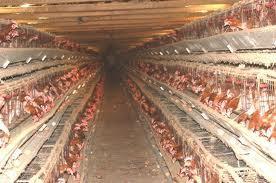
Still today this is the fate of over 20 million hens in the UK alone where battery hens produce 70% of the UK's eggs. If each of us refused to buy eggs from cages eggs we could eliminate the demand for the product, resulting in the collapse of the battery farming system...
The Life of A Battery Hen
The average life of a battery hen is approximately 70 weeks.
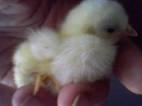 Chicks are manually sorted according to sex at just a day old. The females are separated onto a conveyor belt that transports them to a machine which picks them up by their beak and part of the beak is then cut off. This is called the debeaking process and is done to stop the birds from damaging one another when they peck each other, due to their close confinement. However lots of nerve endings are found in a bird's beak and debeaking can result, not only in terrible pain and deformities for the bird involved, but also irreversible neurological damage.
Chicks are manually sorted according to sex at just a day old. The females are separated onto a conveyor belt that transports them to a machine which picks them up by their beak and part of the beak is then cut off. This is called the debeaking process and is done to stop the birds from damaging one another when they peck each other, due to their close confinement. However lots of nerve endings are found in a bird's beak and debeaking can result, not only in terrible pain and deformities for the bird involved, but also irreversible neurological damage. 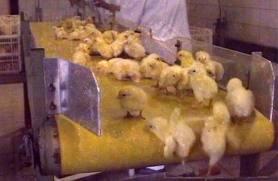
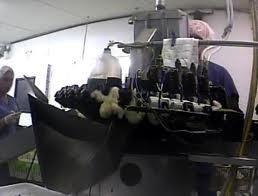
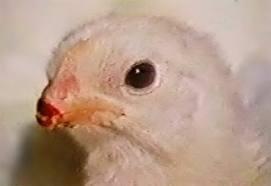
At approximately 18 weeks old the hens are put into the battery cages (after being in indoor hatcheries until then) where they have less than an A4 size space to live until their slaughter, in another 52 weeks. There is no space for a hen to walk, no dustbath, no perch on which they can sleep, no nesting area, just bare wire. They do not have room to stretch their wings and certainly not to turn around or groom themselves.
They will not be taken out of the cage for the entire 52 weeks unless they are dead, and the only time they will be taken from this prison is to be slaughtered. Most birds reach the abattoir with broken legs and wings from rough handling- most are dragged by their legs from the cages and held upside-down and then thrown barbarically into the cages on the transporters. The way in which they end their lives is horrific, shackelled upside-down on a conveyor belt they pass through a machine that cuts their throat (not always successfully), they then have minutes of bleeding to death (the lucky ones) before passing through a boiling shower of water before plucking.
The males which account for over half the chicks in the hatchery, are usually minced alive and used in dog/cat food. Some are gassed and sold to feed reptiles. Depending on company policy. Males are nothing more than a biproduct of the egg industry.
Their life holds no value.
The Lucky Ones...
There are however, some lucky hens that are rescued by a few different organisations, The British Hen Welfare Trust being the largest and most well known in the UK. Their volunteers go in to battery farms and rescue as many hens as possible as often as possible. They rely on donations from re-homers for the hens to pay the farmer the price that the hens would have fetched at slaughter. But these lucky few have a chance at life...
Rescuing A Battery Hen
I was lucky enough to rescue four battery hens in May this year (2011) from the British Hen Welfare Trust at my most local site of Brackley, Northants. After registering it took only a week to reserve and collect my hens. They were rescued from the battery farm at 10.30am and my arranged collection time was 12.30pm. The organisation were efficient and knowledgeable and provide an excellent advice service once you have taken your girls home. I do definately recommend them!
There are usually three categories of battery hen that you might rehome. The roastie- with very few or no feathers at all, what i call the shuttlecocks- with a few feathers, and a bird that does resemble somewhat, a normal hen.
 A typical 'roastie'
A typical 'roastie' 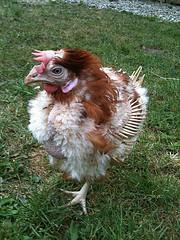 A 'shuttlecock'
A 'shuttlecock' 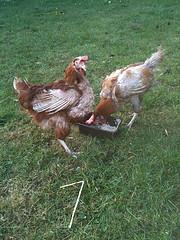 A somewhat 'normal hen'
A somewhat 'normal hen'I chose my four girls (a roastie, two shuttlecocks and a hen with some normal saddle feathers) and took them back to their new home.
 For the first time they could feel grass between their toes and mud in their nails. For the first time they could stretch their wings and walk around. But they did none of this. They stood motionless and occassionally pecked at the wire mesh. They even had to be lifted into the nestbox (which was on the ground when they first arrived) when it began to get dark. They were seeing night for the first time. One hen refused to eat or drink and the other three barely pecked at their mash. Their trauma was evident. Various medical needs made themselves apparent when we looked closely at the birds- though none of them major as the BHWT would then rehabilitate them before rehoming. Henrietta had extensive bruising on her right wing and could not tuck it up properly it was constantly drooping almost to the floor. Chloe (the comb) had pressure sores on her breast bone from her skin rubbing against the wire in the cage and she could not see outof her left eye because her very large comb covered the whole side of her face. The fact that they all were emaciated only exacerbated some of the problems. Georgina was the most severely underweight and violet had seemed to be the most psychologically traumatised.
For the first time they could feel grass between their toes and mud in their nails. For the first time they could stretch their wings and walk around. But they did none of this. They stood motionless and occassionally pecked at the wire mesh. They even had to be lifted into the nestbox (which was on the ground when they first arrived) when it began to get dark. They were seeing night for the first time. One hen refused to eat or drink and the other three barely pecked at their mash. Their trauma was evident. Various medical needs made themselves apparent when we looked closely at the birds- though none of them major as the BHWT would then rehabilitate them before rehoming. Henrietta had extensive bruising on her right wing and could not tuck it up properly it was constantly drooping almost to the floor. Chloe (the comb) had pressure sores on her breast bone from her skin rubbing against the wire in the cage and she could not see outof her left eye because her very large comb covered the whole side of her face. The fact that they all were emaciated only exacerbated some of the problems. Georgina was the most severely underweight and violet had seemed to be the most psychologically traumatised.A day later it was a different story! Even Shrinking Violet (the most traumatised hen who did not eat) was happily exploring the garden and pecking at strands of grass. They were all very nervous, birds scared them, planes, and the noises from neighbouring hens. If the wind blew slightly they would freeze and look almost puzzled. Often their legs would give out as they were not used to walking and they would often stumble and fall as they taught themselves to walk. They also had trouble steering themselves and stopping when they tried to go a little faster. Usually they would crash into an object that they couldn't manage to succefully navigate their way around or wobble violently from side to side with outstretched wings before coming to a halt. They spent a lot of time doing instinctive things that they had never had the opportunity to do before such as nest building and preening themselves (even if they had no feathers).
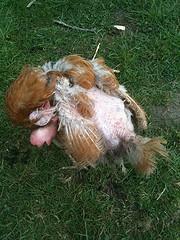
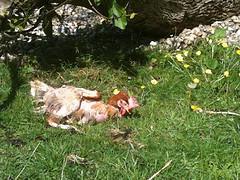
They would collect leaves and build a nest in the bushes and shrubbery and often lay eggs there instead of their nestbox. Most of all they spent hours soaking up the sun...
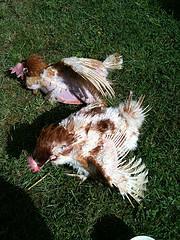
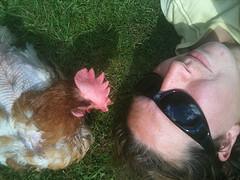
Now almost three months later they are blossoming. They are wonderful unique charaters and a great addition to the family, so friendly and inquisitive they provide hours of entertainment just watching them in the garden. It is a fantastic experience to be able to give these wonderful girls the home they deserve after such a terrible start in life and one of the most rewarding experiences in my life when i see the beautiful hens that they are turning into, happy and clucking and doing everything that a hen should do!
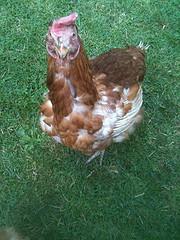
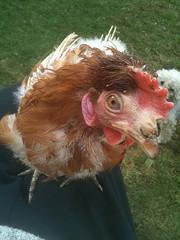
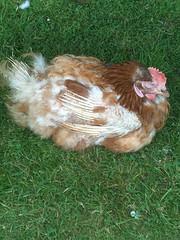
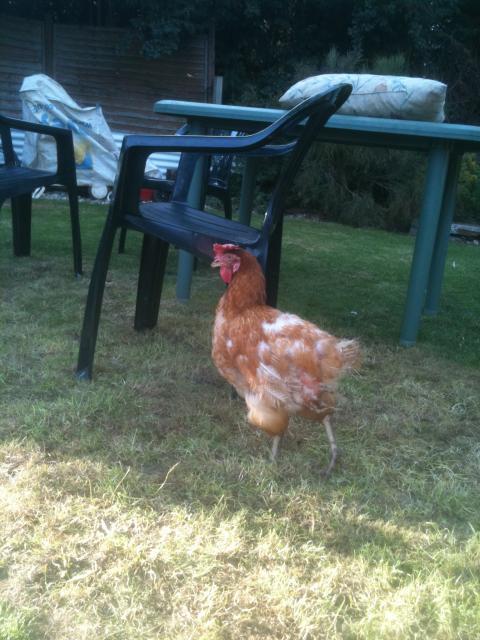
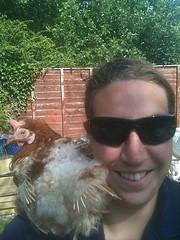

Please if you are considering getting a hen please think about rescuing a battery hen. More information can be found on the British Hen Welfare Trust website.
http://www.bhwt.org.uk/
If you are unable to rescue a hen please help end this terrible practise by boycotting eggs from battery hens and cheap chicken meat products (this is the meat from battery hens that are slaughtered at only 17/18 months old). TOGETHER WE CAN STOP THIS ATROCITY!
